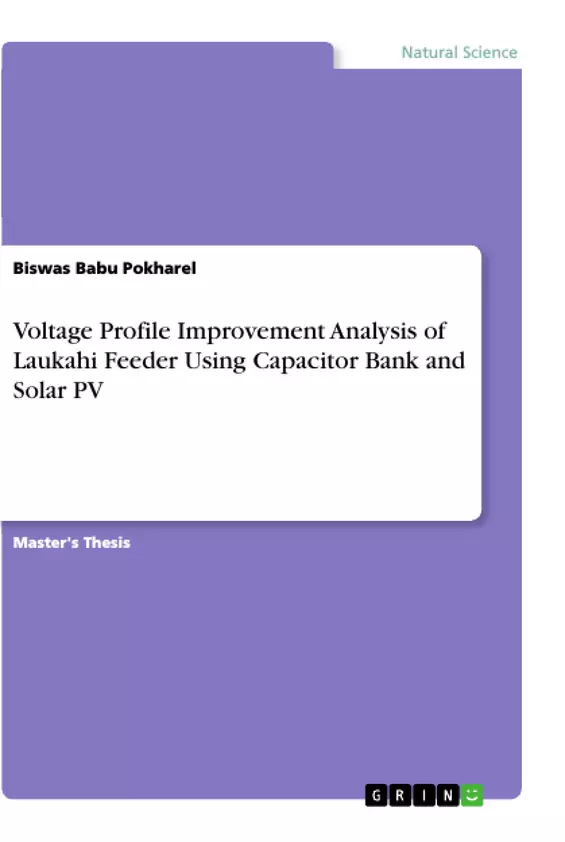This thesis report is an attempt to identify the causes and probable solution of voltage profile issues in the Terai part of Nepal, specifically focused on Laukahi feeder. This radial feeder, Laukahi, is approximately 65km and distributed with 11KV system voltage where the inception point is Inaruwa sub-station and terminates with various parts of Sunsari district, Nepal.
Currently, many villages farther than this substation are getting extremely poor voltages with frequent interruption of the power supply. Irrigation projects and grinding mills located at these places are unable to operate at its optimum capacity. In addition, small consumers are unable to run electrical appliances all the time in a day, not even an electric fan in hot season. To analyze this problem, identical system has been developed in MATLAB, and possible solutions are recommended.
Solar PV and Capacitor banks are using as an active and a reactive power generating sources have to penetrate at suitable buses of the system in order to improve the voltage profile of the feeder and to reduce the branch loss as well. Suitable size and location of the DG sources has been identified by using Ant Colony Optimization techniques. After integrating the active sources and reactive sources, branch losses of the system have been significantly reduced and the voltage profile has been improved at permissible level. IEEE 33 bus and IEEE 10 bus system has been adopted to validate the test results.
Inhaltsverzeichnis (Table of Contents)
- CHAPTER 1 INTRODUCTION
- 1.1 Background
- 1.2 Statement of problem
- 1.3 Significance of the study
- 1.4 Objectives
- 1.5 Limitations of the study
- 1.6 Organization of dissertation work
- CHAPTER 2 LITERATURE REVIW
- 2.1 Electrical distribution system
- 2.2 Load Flow
- 2.3 Distributed Generation (DG):
- 2.3.1 Solar PV as a DG source
- 2.3.2 Capacitor Bank as a reactive power source
- 2.4 Optimization Techniques
- 2.4.1 Ant Colony Optimization (ACO)
- CHAPTER 3 METHODOLOGY
- 3.1 Data collection
- 3.2 Load flow analysis using Forward/ Backward sweep algorithm
- 3.2.1 Backward sweep algorithm
- 3.2.2 Forward sweep algorithm
- 3.3 Branch loss calculation
- 3.4 Estimation of DG sizes
- 3.5 Location of DG penetration
- 3.5.1 Generating size and number of ants
- 3.5.2 Flow chart of Load flow (Forward/ Backward sweep algorithm)
- 3.5.3 Flow chart of ACO
- 3.6 Financial analysis of the proposed system
- CHAPTER 4 DESCRIPTION OF EXISTING SYSTEM
- 4.1 Introduction
- 4.1.1 Inaruwa DCS
- 4.1.2 Laukahi feeder
- CHAPTER 5 RESULTS AND DISCUSSION
- 5.1 IEEE 10 bus system
- 5.1.1 Load flow of IEEE 10 bus system
- 5.1.2 Implementation of ACO techniques in IEEE 10 bus system
- 5.1.3 DG integration in IEEE 10 bus
- 5.2 IEEE 33 bus test system
- 5.2.1 Load flow of IEEE 33 bus system
- 5.2.2 ACO technique implementation on IEEE 33 bus system
- 5.2.3 DG integration on IEEE 33 bus
- 5.2.4 ACO and PSO comparison in IEEE 33 bus system
- 5.2.5 Summary of Results for IEEE test Radial Distribution System
- 5.3 Laukahi feeder
Zielsetzung und Themenschwerpunkte (Objectives and Key Themes)
This dissertation investigates the causes and potential solutions for voltage profile issues in the Terai region of Nepal, focusing specifically on the Laukahi feeder. The primary objective is to analyze the voltage profile of the Laukahi feeder and recommend solutions to improve it. The study utilizes MATLAB simulations to model the system and assess the effectiveness of potential solutions.
- Voltage profile improvement in the Laukahi feeder.
- Analysis of the impact of distributed generation (DG) on the voltage profile.
- Integration of solar PV and capacitor banks as DG sources.
- Application of optimization techniques, particularly Ant Colony Optimization (ACO), to identify optimal DG locations and sizes.
- Evaluation of the financial feasibility of proposed solutions.
Zusammenfassung der Kapitel (Chapter Summaries)
Chapter 1 provides an introduction to the problem, outlining the background, statement of the problem, significance, objectives, limitations, and the dissertation's organization. Chapter 2 reviews relevant literature on electrical distribution systems, load flow analysis, distributed generation (DG), and optimization techniques such as Ant Colony Optimization (ACO).
Chapter 3 describes the methodology used in the study. This includes data collection, load flow analysis using forward/backward sweep algorithms, branch loss calculation, estimation of DG sizes, identification of optimal DG penetration locations using ACO, and financial analysis of the proposed solutions.
Chapter 4 details the existing system, including the Inaruwa Distribution Control System (DCS) and the Laukahi feeder.
Chapter 5 presents the results and discussion. It includes simulations on IEEE 10 bus and IEEE 33 bus test systems, demonstrating the effectiveness of the proposed solutions in improving voltage profiles and reducing branch losses. The chapter also provides insights into the performance of ACO and Particle Swarm Optimization (PSO) techniques in DG integration.
Schlüsselwörter (Keywords)
This dissertation focuses on voltage profile improvement, distributed generation (DG), solar PV, capacitor banks, Ant Colony Optimization (ACO), load flow analysis, branch losses, and radial distribution systems.
- Quote paper
- Biswas Babu Pokharel (Author), 2019, Voltage Profile Improvement Analysis of Laukahi Feeder Using Capacitor Bank and Solar PV, Munich, GRIN Verlag, https://www.grin.com/document/465349



